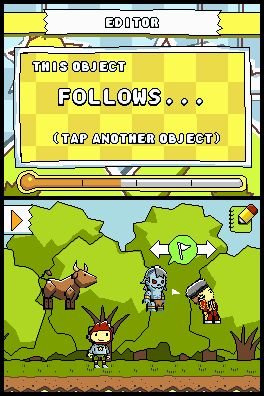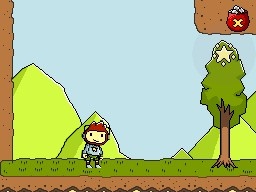Scribblenauts Updated Hands-On
5th Cell's delightful platformer won our game of E3 2009 award, and we recently got another chance to experience this very special game.
Scribblenauts is a platformer-cum-puzzle game that stole the limelight at this year's E3. It made such an impression, that we named it our own Game of the Show, beating such heavyweights as Splinter Cell: Conviction and God of War III. Since then, we've had a chance to spend some more time with this delightful DS game, and we're pleased to report that it's still a unique experience to savour.
Another Crab's Treasure Is A Soulslike 3D Platformer | GameSpot Review Stellar Blade Review Super Monkey Ball Banana Rumble - Official Multiplayer Features Trailer Nintendo 64 – April 2024 Game Updates – Nintendo Switch Online PUBG | Erangel Classic Returns Gori: Cuddly Carnage | Meow Launch Date Announcement Trailer Genshin Impact - "Arlecchino: Afterglow of Calamity" | Collected Miscellany Marvel Rivals - Official Loki Character Reveal Trailer | The King of Yggsgard Fortnite Festival - Official Billie Eilish Cinematic Season 3 Trailer Remnant 2 - The Forgotten Kingdom | DLC Launch Trailer Stellar Blade - Official "The Journey: Part 2" Behind The Scenes Trailer | PS5 Games Dead by Daylight | Tome 19: Splendor | Reveal Trailer
Please enter your date of birth to view this video
By clicking 'enter', you agree to GameSpot's
Terms of Use and Privacy Policy
If you're unfamiliar with Scribblenauts, then this isn't your typical, run-of-the-mill experience. It's a mix of platformer and puzzle game, but what makes it so special is how you actually play. You write words using the stylus on the touch screen, and then the item you've written will appear in front of you. You can then use these objects to help solve the puzzles you're presented with; in other words, it's a completely new concept in video games.
Naturally, there are a few limitations to the system. The game won't recognise names, places, shapes, root words, and mature or vulgar content, and anything that's copyrighted can't be used. There's also a limit to how many objects you can place in a level because each object takes up a certain amount of the onscreen memory bar. It's easy to delete an item and start again simply by dragging and dropping the item into a trash can on the touch screen. On one level, we tried writing "fly spray" and "repellent" on a fly, but in this case, "bug spray" and "insect spray" were the acceptable solutions. The sheer amount of objects in the database is amazing, and while you may stump it occasionally (for example, Devonshire tea appears in the form of a cup of tea), this is usually the exception to the rule.
Warner Brothers swung by the GameSpot UK offices this week to give us another round with the game, while 5th Cell technical director Marius Fahlbusch was on hand to get our adventure started. The game begins with a neat menu screen that you can interact with the same way as you would a regular level. Given that we're located in London, Fahlbusch dropped in a royal banquet, including the Queen, a table, a grill, beef, and a chef's hat. Rather amusingly, he then also added a vampire that quickly turned the Queen into a fellow vampire. Thankfully for Maxwell--the game's protagonist--there was some nearby garlic bread to help keep the vampires at bay.

There are two types of levels in Scribblenauts--platform and puzzle. The platform missions are linear point-to-point levels with a few obstacles thrown into the equation. To complete them, you need to find the starite, a star-shaped item located at the end of the level. In puzzle levels, you're given a hint, and once you solve the puzzle, you'll earn a starite. There are 220 levels in total split across 10 worlds, and you can unlock them by earning the game's currency: ollars. At the end of each level, you're awarded ollars for completing the stage under the target time and within par--the number of objects it should take to complete the level. You can also earn achievements by using new objects or completing a level without the use of weapons.
Fahlbusch demonstrated the physics engine with a stage that featured a starite atop a tree. There were numerous ways to get to it, including the use of a ladder or termites that would eat the tree. Instead, he added two acrobats and placed Maxwell on top of them, allowing him to reach the starite. Each stage has three levels of difficulty, and because you can't reuse items, you need to put your thinking cap on to come up with more creative ways to beat each level. One level we played required us to save a cat stuck on top of a house. The obvious choice would have been to use a fireman, however, we were able to use a fish tied to a helium balloon to coax the cat down.
There's also a level editor to create brand new levels, and you can even get a head start by using existing templates. You can drop AI characters into your level and change their behaviour (for example, protecting, consuming, or scaring a certain object), add objects, drop in a hint, and then place the starite. You can also save your levels and share them with friends over local Wi-Fi and online. We could only create platform levels in our demo build, but we're hoping that the final build will also allow you to create puzzle-based ones. Either way, it appears to be a great addition to Scribblenauts, and we look forward to spending more time with the level editor in the future.

Given that 5th Cell also developed Drawn to Life, it's not surprising that both games have a similar art style, with Scribblenauts boasting a rough, hand-drawn style that suits the game perfectly. The most impressive aspect of the game's visuals is that all of the objects we drew actually looked pretty much as we expected and could be instantly recognised despite the DS's low-resolution screen.
Scribblenauts is coming to the Nintendo DS this September, and for more on this charming experience watch our video interviews from E3 2009.
Got a news tip or want to contact us directly? Email news@gamespot.com
Join the conversation